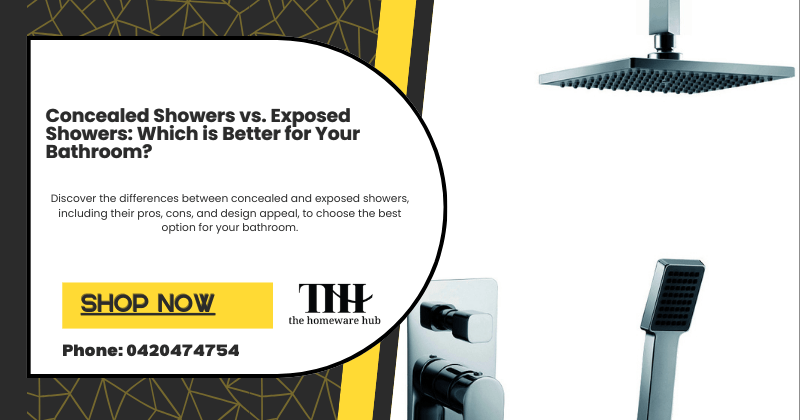Concealed Showers vs. Exposed Showers: Which is Better for Your Bathroom?
Date Posted:12 November 2024
When it comes to bathroom design, the choice between a concealed shower and an exposed shower can have a significant impact on the style, functionality, and maintenance of your space. Both options have unique benefits, and understanding their differences can help you make the best decision for your bathroom renovation. Here’s an in-depth comparison to guide you.

What is a Concealed Shower?
In a concealed shower setup, all plumbing fixtures, including pipes, valves, and fittings, are hidden behind the wall. Only the essential components, such as the showerhead and control handles, are visible.
Pros of Concealed Showers:
- Sleek and Minimalist Look: Creates a clean, uncluttered look, ideal for modern bathrooms.
- Space-Saving Design: By hiding plumbing, concealed showers are great for smaller bathrooms where every inch counts.
- Flexible Layout Options: Concealed setups allow more customization with showerheads, handles, and control placement.
Cons of Concealed Showers:
- Higher Installation Costs: Concealed showers usually require more labor and wall modifications, making installation pricier.
- Challenging Repairs: If there’s an issue with internal plumbing, you may need to remove parts of the wall, which can add time and expense to repairs.
Also Check: How Do You Proceed With Finding The Right LED Mirror?
What is an Exposed Shower?
An exposed shower displays all pipes and fixtures, typically mounted on the bathroom wall. This style suits industrial or vintage-inspired bathrooms where the exposed piping enhances the aesthetic.
Pros of Exposed Showers:
- Easier Installation and Maintenance: Exposed showers are simpler to install and repair, as all components are accessible.
- Lower Installation Costs: With no need for wall modifications, exposed showers are more budget-friendly.
- Unique Design Appeal: Exposed piping can add character, making it popular in industrial and rustic-style bathrooms.
Cons of Exposed Showers:
- Bulkier Appearance: The visible piping and fixtures may take up more space and can make smaller bathrooms feel cluttered.
- Limited Modern Appeal: Exposed showers may not suit every aesthetic, especially in minimalist or ultra-modern bathrooms.
Also Check: A Guide to Must-Have Bathroom Accessories
Choosing the Right Look for Your Bathroom
Concealed Showers:
Concealed showers are best for those looking to create a sleek, minimalist aesthetic. Their hidden design is popular in contemporary and high-end bathrooms, where simplicity and elegance are prioritized. Paired with a rainfall or handheld showerhead, concealed showers offer a luxurious and spa-like experience.
Exposed Showers:
Exposed showers offer a vintage or industrial charm. The visible piping adds a bold design element, making them ideal for bathrooms with rustic, traditional, or industrial decor. With finishes in polished chrome, brass, or matte black, exposed showers become a focal point that adds character and warmth.
Installation and Maintenance: What’s Easier to Manage?
- Concealed Showers: These showers require opening up walls to install plumbing within, making the installation more complex and costly. This setup is usually recommended for new builds or full bathroom renovations.
- Exposed Showers: Exposed showers are simpler to install, as there’s no need to alter walls. They’re an ideal option for quick upgrades or retrofitting existing bathrooms.
Maintenance:
- Concealed Showers: Repairs are more challenging since the internal plumbing is hidden behind the wall, often requiring professional help.
- Exposed Showers: With everything visible, leaks or maintenance issues are easier to address without major modifications.
Water Pressure and Temperature Control Options
Both concealed and exposed showers can deliver excellent water pressure and temperature control, especially with the right type of valve:
- Thermostatic Valves: These valves are commonly used in both concealed and exposed showers to maintain a consistent water temperature, making them ideal for family bathrooms.
- Manual Valves: More affordable, these valves are simple to operate but may require more frequent adjustments to maintain the desired temperature.
Also Check: Top 5 Benefits of Using Concealed Shower Mixer Valves
Practical Features and Customization Options
Concealed Showers:
- Greater customization flexibility, as you can position the controls, diverters, and showerheads independently for maximum comfort.
- Options to include multiple showerheads or body sprays, making them perfect for a luxury experience.
Exposed Showers:
- While the setup is more fixed, some models offer adjustable showerheads or additional handheld attachments. However, customization options are generally more limited.
Cost Comparison: Budget Considerations
- Concealed Showers: Generally come with higher installation and repair costs due to the need for wall modifications and hidden plumbing. These showers are often preferred in high-end designs but may not be the best choice for budget-conscious remodels.
- Exposed Showers: With simpler installation and accessibility, exposed showers are typically more budget-friendly, both in upfront costs and future maintenance.
Conclusion: Which Shower Style is Right for You?
Your choice between a concealed and an exposed shower will depend on your bathroom’s design, budget, and maintenance needs.
- Choose a Concealed Shower if: You want a modern, minimalist look and are willing to invest in a more complex installation for a high-end finish.
- Choose an Exposed Shower if: You’re looking for a quick, affordable installation with easy maintenance, or if you love the industrial, vintage charm it brings to the space.
For a wide range of concealed and exposed shower options, check out our selection at The Homeware Hub, where you’ll find quality fixtures that fit every style and budget.
Concealed vs. Exposed Showers FAQs
1. Can I convert an exposed shower to a concealed one?
Yes, but this would require significant modifications, including wall work to hide the plumbing.
2. Which is more durable: concealed or exposed showers?
Both types are durable with quality components, but concealed showers may be harder to repair in the event of hidden leaks.
3. Are concealed showers more expensive to maintain?
Yes, if repairs are needed, accessing concealed plumbing can be more costly and time-consuming than exposed setups.








